Nicole schreibt...
Rhineland 2023 |
 |
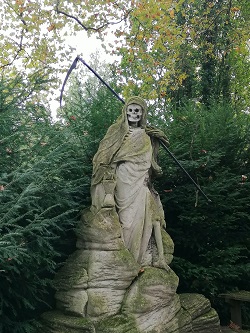 A travel report on the Rhineland... wait, isn't that where you live? Well, yes. But the travel section of this website has recently suffered from my New York obsession (which can be found in the theatre section) and I've had a friend staying for some days, so taking him to see the sights was an interesting experience for me as well. So here's a bit about my own area and (some of) the interesting places worth seeing around here.
Which includes the scary fella on the right side. Since I live right beside Cologne's famous Melaten cemetary, it made sense to begin our first sightseeing walk right here, along several of the massive ancient tombs and graves of the old rich families of the city and various celebrities and past this guy, who has become something of an inofficial icon of the cemetary. From here it was onwards into town and past a few other bits and bobs to one of the few sources of proper civic pride: The last remaining watch tower of the Roman town wall, which has stood in its place for more than 2000 years now.
A travel report on the Rhineland... wait, isn't that where you live? Well, yes. But the travel section of this website has recently suffered from my New York obsession (which can be found in the theatre section) and I've had a friend staying for some days, so taking him to see the sights was an interesting experience for me as well. So here's a bit about my own area and (some of) the interesting places worth seeing around here.
Which includes the scary fella on the right side. Since I live right beside Cologne's famous Melaten cemetary, it made sense to begin our first sightseeing walk right here, along several of the massive ancient tombs and graves of the old rich families of the city and various celebrities and past this guy, who has become something of an inofficial icon of the cemetary. From here it was onwards into town and past a few other bits and bobs to one of the few sources of proper civic pride: The last remaining watch tower of the Roman town wall, which has stood in its place for more than 2000 years now.
 It's really twice as tall as it looks, because so much debris and earth accumulated over the centuries, forming new layers of soil. Still, it's a nifty memory of the time when the Romans set up shop on the left bank of the Rhine and this camp quite accidentally became the birthplace of future Empress Agrippina The Younger (whose Dad Germanicus ran the Roman legions in Germany at the time). Agrippina, one of the most fascinating ladies of Ancient Rome, later rewarded her birthplace by raising its rank to City, making it Colonia Claudia Ara Agrippinensium, which was quite a mouthful, so it became Colonia and finally Köln or Cologne.
It's really twice as tall as it looks, because so much debris and earth accumulated over the centuries, forming new layers of soil. Still, it's a nifty memory of the time when the Romans set up shop on the left bank of the Rhine and this camp quite accidentally became the birthplace of future Empress Agrippina The Younger (whose Dad Germanicus ran the Roman legions in Germany at the time). Agrippina, one of the most fascinating ladies of Ancient Rome, later rewarded her birthplace by raising its rank to City, making it Colonia Claudia Ara Agrippinensium, which was quite a mouthful, so it became Colonia and finally Köln or Cologne.
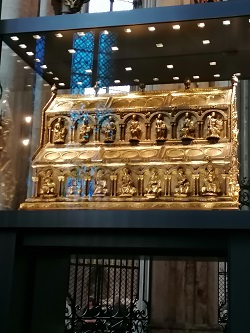 During medieval times, Cologne was only a medium important town until archbishop Rainald von Dassel plodded off to Italy to support the Holy Roman Emperor in his beef with Milan. He conquered the city and took home the bones of the Three Wise Men, which were placed in a massive golden shrine and launched Cologne into the Top Five pilgrimage sites in Europe. Money coming in meant they could build a new church, which ended up taking several hundred years. The Rhinelanders, never known for their work enthusiasm, needed the Prussians to occupy the city in 19th century to finally get the majestic Kölner Dom, our cathedral, completed, but it has since become the one big identification marker of the city and its people and the most-visited sight in Germany.
The shrine of the Magi still takes pride of place in the cathedral behind the main altar, but there's plenty more amazing stuff to look at, such as the Agilolphosaltar (left) and the Klarenaltar. Agilolf was one of Cologne's earliest arch bishops (8th Century), while the other altar piece had originally been meant for the church of St. Clara, from where it was moved when the church was torn down:
During medieval times, Cologne was only a medium important town until archbishop Rainald von Dassel plodded off to Italy to support the Holy Roman Emperor in his beef with Milan. He conquered the city and took home the bones of the Three Wise Men, which were placed in a massive golden shrine and launched Cologne into the Top Five pilgrimage sites in Europe. Money coming in meant they could build a new church, which ended up taking several hundred years. The Rhinelanders, never known for their work enthusiasm, needed the Prussians to occupy the city in 19th century to finally get the majestic Kölner Dom, our cathedral, completed, but it has since become the one big identification marker of the city and its people and the most-visited sight in Germany.
The shrine of the Magi still takes pride of place in the cathedral behind the main altar, but there's plenty more amazing stuff to look at, such as the Agilolphosaltar (left) and the Klarenaltar. Agilolf was one of Cologne's earliest arch bishops (8th Century), while the other altar piece had originally been meant for the church of St. Clara, from where it was moved when the church was torn down:
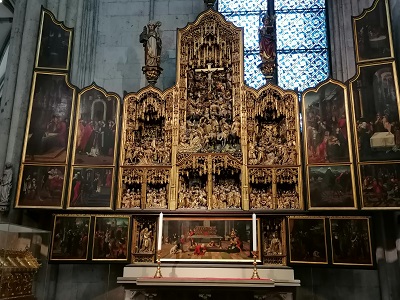
|
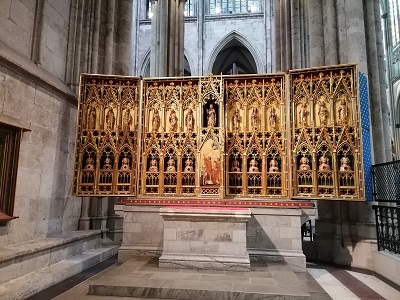 |
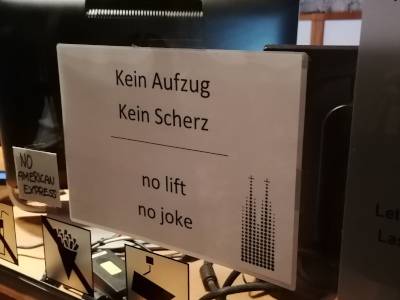
|
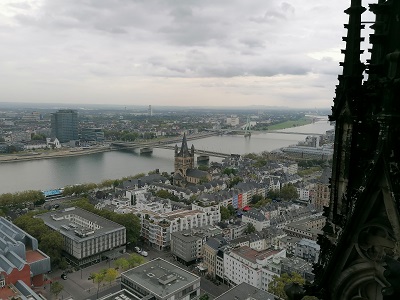 |
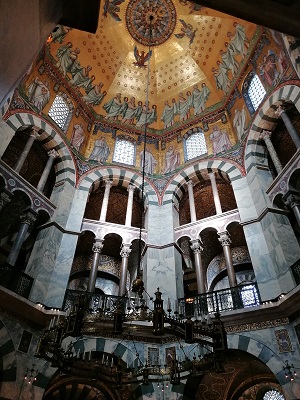 The second outing took us to my former home town Aachen, which I feel is often given short shrift despite its incredible heritage and historical importance. It was here, lured by hot thermal springs (which had attracted the inevitable Romans before and made them to establish a settlement they called Aquis Grana), that the Frankish Emperor Charlemagne set up shop and created the capital of a new vast empire that spanned parts of what's now France and Germany (and everything in-between).
His court was the first large stone building in the area since Roman times and he (himself illiterate) encouraged monks to learn to read and write to capture knowledge on the written page. And more astonishingly, most of his palace from 9th century still exists with the modern Town Hall of Aachen developing from his actual palace and his gorgeous byzantine chapel (left) part of the Aachener Dom. For centuries after, during the days of the Holy Roman Empire, this is where the German Emperors were crowned and Friedrich Barbarossa donated the massive chandelier visible in the picture.
The Katschhof between cathedral and town hall has recently (finally!) added the Centre Charlemagne as a very worthy museum to introduce the man to the world. Here's the back view of the town hall facing the Katschhof and the front view on the Markt with the famous Charlemagne fountain, Aachen's favourite place to meet up.
The second outing took us to my former home town Aachen, which I feel is often given short shrift despite its incredible heritage and historical importance. It was here, lured by hot thermal springs (which had attracted the inevitable Romans before and made them to establish a settlement they called Aquis Grana), that the Frankish Emperor Charlemagne set up shop and created the capital of a new vast empire that spanned parts of what's now France and Germany (and everything in-between).
His court was the first large stone building in the area since Roman times and he (himself illiterate) encouraged monks to learn to read and write to capture knowledge on the written page. And more astonishingly, most of his palace from 9th century still exists with the modern Town Hall of Aachen developing from his actual palace and his gorgeous byzantine chapel (left) part of the Aachener Dom. For centuries after, during the days of the Holy Roman Empire, this is where the German Emperors were crowned and Friedrich Barbarossa donated the massive chandelier visible in the picture.
The Katschhof between cathedral and town hall has recently (finally!) added the Centre Charlemagne as a very worthy museum to introduce the man to the world. Here's the back view of the town hall facing the Katschhof and the front view on the Markt with the famous Charlemagne fountain, Aachen's favourite place to meet up.
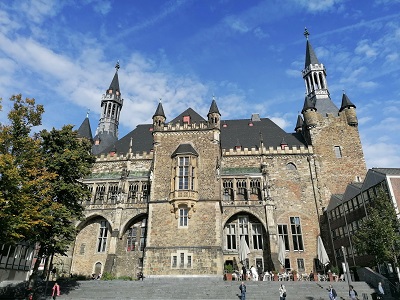
|
 |
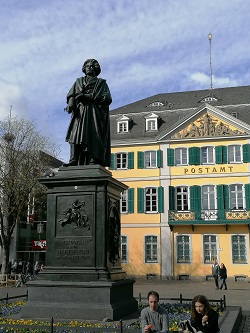 From Aachen it was onwards to dear old little Beggendorf where I grew up (no, no photos) and back to Cologne for the evening performance of "Moulin Rouge" at the Musical Dome.
Next up on the agenda was sleepy Bonn, which once glowed in the international spotlight as capital of West-Germany until 1990, when that shambolic pile of megalomania further east was once more elected capital of a newly united Germany. Still Bonn has lots of other cool things going for it, not least the fact that composer Ludwig van Beethoven was born here and got everything and the kitchen sink named for him.
Here he lords it over the pretty Münsterplatz beside the cathedral, although our first main destination was his birth house, which has been transformed into a nice museum with lots of personal bits and pieces on display, including the poor man's hearing aids with which he tried to combat his increasing deafness.
From Aachen it was onwards to dear old little Beggendorf where I grew up (no, no photos) and back to Cologne for the evening performance of "Moulin Rouge" at the Musical Dome.
Next up on the agenda was sleepy Bonn, which once glowed in the international spotlight as capital of West-Germany until 1990, when that shambolic pile of megalomania further east was once more elected capital of a newly united Germany. Still Bonn has lots of other cool things going for it, not least the fact that composer Ludwig van Beethoven was born here and got everything and the kitchen sink named for him.
Here he lords it over the pretty Münsterplatz beside the cathedral, although our first main destination was his birth house, which has been transformed into a nice museum with lots of personal bits and pieces on display, including the poor man's hearing aids with which he tried to combat his increasing deafness.
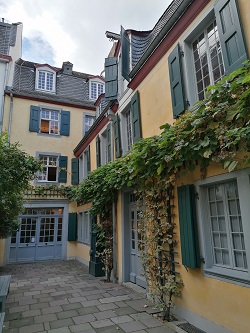
|
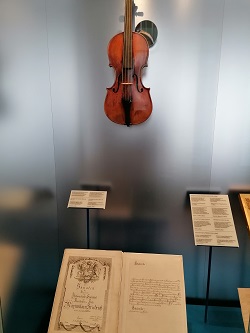
|
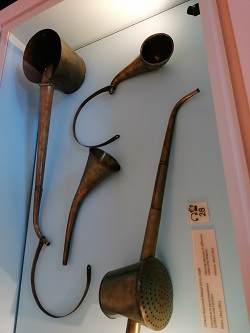 |
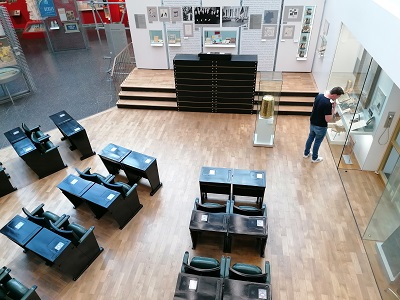 Second stop was a place very dear to my heart, the Haus der Deutschen Geschichte, a museum dedicated to the "new" Germany that rose from the ashes of WWII and always feels like a trip back into my own childhood and youth, with its mixture of political exhibits and every day items from former decades. Here's a glimpse of (parts of the old) "assembly" where the German Bundestag used to meet while still in Bonn, as well as one of the first Italian "bars" that arrived in West-Germany in the 60s along with the first Italian migrants and a typical VW Bulli, everyone's favourite vehicle of the 70s (here decked out as a hippie bus of the era kids would travel all over Europe with).
They keep adding to the museum to keep pace with modern history and as a result it's become quite a huge exhaustive place by now, so maybe some pruning might help.
Second stop was a place very dear to my heart, the Haus der Deutschen Geschichte, a museum dedicated to the "new" Germany that rose from the ashes of WWII and always feels like a trip back into my own childhood and youth, with its mixture of political exhibits and every day items from former decades. Here's a glimpse of (parts of the old) "assembly" where the German Bundestag used to meet while still in Bonn, as well as one of the first Italian "bars" that arrived in West-Germany in the 60s along with the first Italian migrants and a typical VW Bulli, everyone's favourite vehicle of the 70s (here decked out as a hippie bus of the era kids would travel all over Europe with).
They keep adding to the museum to keep pace with modern history and as a result it's become quite a huge exhaustive place by now, so maybe some pruning might help.
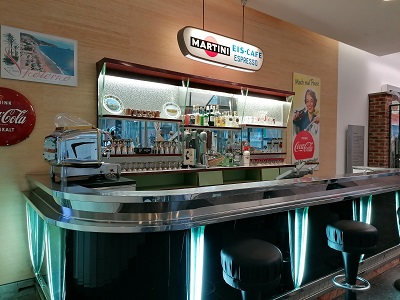
|
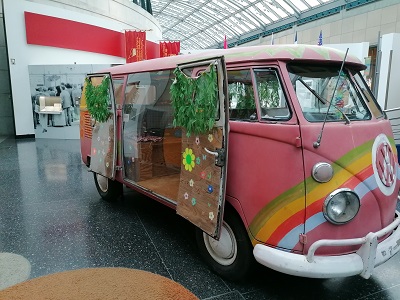 |
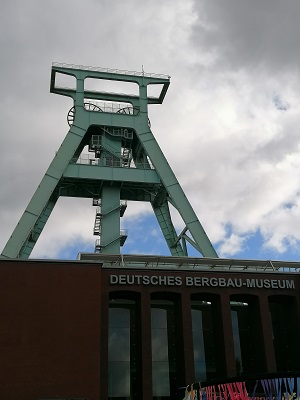 Since my friend and I had met over musicals many years ago and he had regularly heard about "Starlight Express", it was a no-brainer to take him to Bochum to see this truly unique musical for himself - where it's been running for an incredible 35 years now and shows no sign of slowing down.
And since we were there anyway, it made sense to stop by the Deutsche Bergbau Museum, the Ruhr Valley's foremost museum to honour coal mining, which dominated the area for centuries. For some reason I had never been there (it doesn't help that the theatre is conveniently next to a motorway exit, so there's never any reason to go deeper into Bochum itself) despite having personal connections to coal mining as our own area around Aachen was a mining area as well and my own grandpa worked down the mines in our local colliery back then (way before my time).
So between this personal angle and the museum being truly amazing, it was probably the highlight of this trip for me. I knew you could go underground to view a bit of an old mine, but I had no idea just how extensive that was and how impressively it brought home working conditions in the lightless dangerous underworld for so many men for so many years.
Since my friend and I had met over musicals many years ago and he had regularly heard about "Starlight Express", it was a no-brainer to take him to Bochum to see this truly unique musical for himself - where it's been running for an incredible 35 years now and shows no sign of slowing down.
And since we were there anyway, it made sense to stop by the Deutsche Bergbau Museum, the Ruhr Valley's foremost museum to honour coal mining, which dominated the area for centuries. For some reason I had never been there (it doesn't help that the theatre is conveniently next to a motorway exit, so there's never any reason to go deeper into Bochum itself) despite having personal connections to coal mining as our own area around Aachen was a mining area as well and my own grandpa worked down the mines in our local colliery back then (way before my time).
So between this personal angle and the museum being truly amazing, it was probably the highlight of this trip for me. I knew you could go underground to view a bit of an old mine, but I had no idea just how extensive that was and how impressively it brought home working conditions in the lightless dangerous underworld for so many men for so many years.
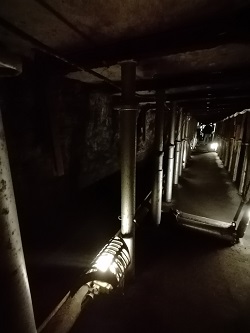
|
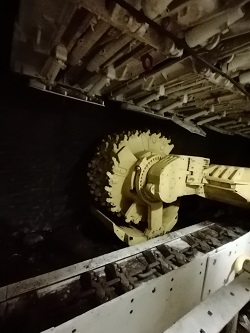
|
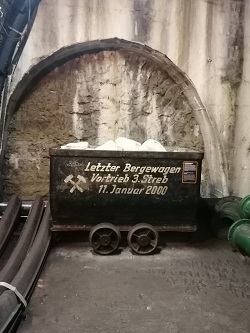 |
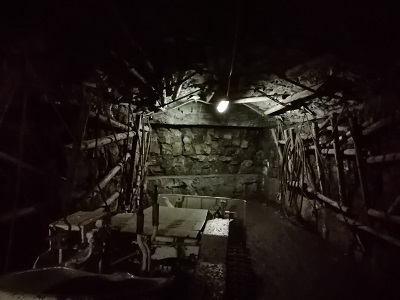
|
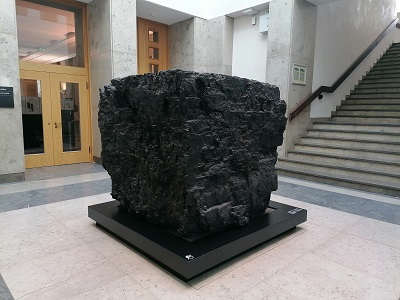 |
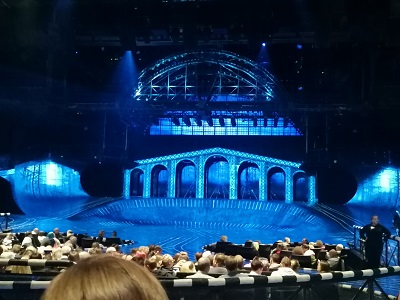
And just like the Ruhr Valley in general, my erstwhile beloved Starlight Express is only a shadow of its former self these days with the "revisions" for the 30th anniversary ruining the first 15-20 minutes beyond repair especially, but nonetheless it remains an amazing unique piece of theatre and the end of the day I was happy to be there once more - and a wonderful end to some exhausting but still very interesting days of sightseeing in my own backyard.
Copyright © All Rights Reserved